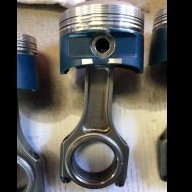Announcements
-
Similar Content
-
Latest Posts
-
By TurboTapin · Posted
The SS button head cap screw on the back? If so, good to know. I presumed it was there for basic assembly and nothing more. -
Hello, everyone. I'm new to the forum. I have a 1989 Nissan Skyline R32 GTR. I have lost all power to the interior, including AC controls, the gauge cluster, turn signals, and windows. Stuff that still works includes the horn, brake lights, radio, and headlights. All fuses, in the interior and exterior boxes, tested good. It starts and runs fine, just with no gauge power or anything stated above. No warning lights either. Things that I have tested: - Fusable link tested fine - No other fuses blown - Alternator good - IGN switch tested fine - With my power probe, I can backfeed power through the IGN pin to the plug on the back of the gauge cluster, and everything comes back on. So my theory is something on the control side that sends the ignition power through the system isn't doing its job, or a wire is broken. (I would think that it is the ignition switch that would do that, but who knows?). The ignition relays don't fire (all relays tested good). So what tells them to fire other than the IGN switch? I would really appreciate it if someone had some insight on this. I have tons of hours into this; I don't want to give up in defeat! I have the HD wiring diagram, but having all those wires laid out like that on one sheet of paper makes things pretty hard to follow. Thanks for reading, and thanks for the replies. Where should I look next? Thanks.
-
By Dose Pipe Sutututu · Posted
Install a MAP sensor pre and post throttle. Best data you could have for NA, then play with the bends and/or air box and see how much of inflection is created at WOT on the plot. -
The car remains in paint jail. I am now pretty convinced that the whole "RB25 Airboxes are kinda limiting to ~300kw" could be a thing. Also saw a good video from Engine Masters: (Sorry for FB link) (https://www.facebook.com/watch/?ref=search&v=761771519471924&external_log_id=c10bcbb6-2c39-4ff3-9240-287e9921fde6&q=Cold Air Considerations) Where they tested Pod Filter sizes and kept adding bends to a LS3 on an Engine Dyno to find if bends caused power loss. It's a good video worth watching - They did lose ~25hp from making an intake which had 3x90's and a 120 degree. They only lost maybe 1hp with a basic 90. I feel that by sealing up my airbox I have: 1) Created the same restriction a stock airbox would have. 2) Created a very convoluted set of intake 'pipes' by forcing all the air through the ducts. So I am pretty confident I'll be going full circle and have a huge hot air intake pod and actually see a benefit. The air does *not* stay hot once it gets flowing, aided by the ducts, and the pod can then pull air from anywhere. All the posts of yore talk about the stock airbox costing 10-15kw at 300kw+ but you know what? I f**king would very much like that 10-15kw and I remember my own pod filter in engine bay experiences. Turns out the GTT Reo and Headlight brackets really don't allow you to mount GTR items, no matter what the internet says. Various brackets have had to be made up to actually make it fit right for the front bar. Also some idiot mounted a 3L Accusump right where the bumper wants to go, so that has had to be 'relocated' To where, I am still not sure, but it's supposedly mounted in the pictures and I can't see it.
-








Recommended Posts
Create an account or sign in to comment
You need to be a member in order to leave a comment
Create an account
Sign up for a new account in our community. It's easy!
Register a new accountSign in
Already have an account? Sign in here.
Sign In Now